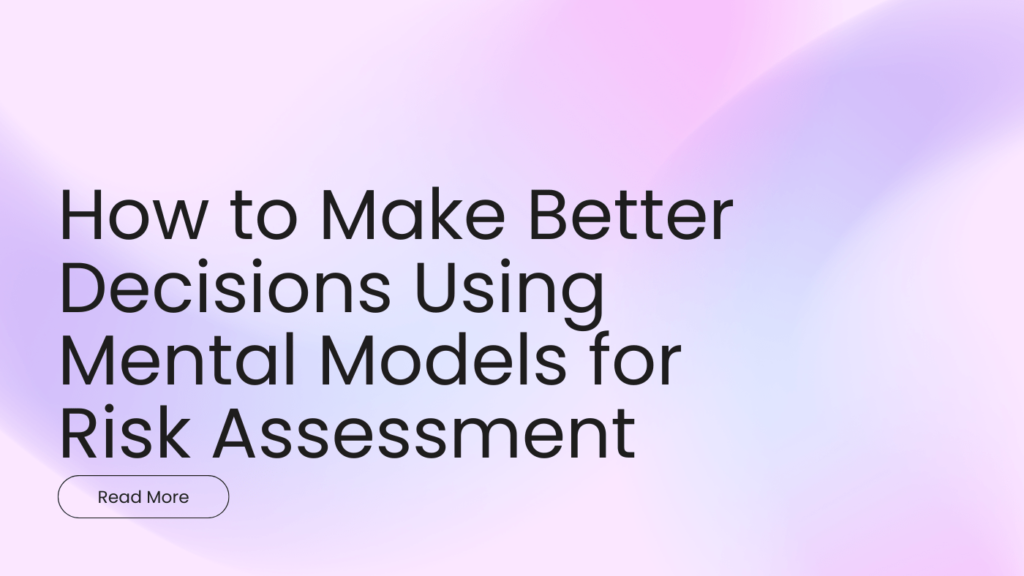How to Make Better Decisions Using Mental Models for Risk Assessment
Making smart decisions, especially when facing uncertainty, is a crucial skill in both professional and personal life. We’re constantly bombarded with choices, and the quality of those choices directly impacts our outcomes. This article explores how leveraging mental models for risk assessment can significantly improve your decision-making process, leading to more informed and favorable results. Forget gut feelings; let’s dive into a structured approach!
What are Mental Models?
Mental models are simplified representations of how something works. They are cognitive frameworks that help us understand the world, predict outcomes, and make decisions. Think of them as internal “maps” that guide our understanding and actions. These models aren’t always perfect, but they provide a crucial foundation for navigating complex situations. As Shane Parrish eloquently puts it on Farnam Street, mental models provide “a toolkit for understanding and improving your thinking.” (Farnam Street, https://fs.blog/mental-models/)
Essentially, they act as filters for information, allowing us to prioritize relevant details and discard the noise. By consciously developing and applying mental models, we can overcome cognitive biases and make more rational choices, especially when it comes to risk management.
Why Use Mental Models for Risk Assessment?
Traditional risk assessment often relies on quantitative analysis or subjective gut feelings. Mental models offer a powerful middle ground, providing a structured, yet adaptable, framework for understanding potential risks. Here’s why using mental models for risk assessment is beneficial:
- Improved Understanding: They force us to break down complex situations into manageable components.
- Better Prediction: By understanding the underlying dynamics, we can more accurately anticipate potential outcomes.
- Reduced Bias: Mental models help us identify and mitigate cognitive biases that can cloud our judgment.
- Enhanced Communication: They provide a shared framework for discussing risks and potential solutions with others.
- More Effective Mitigation Strategies: By understanding the root causes of risks, we can develop more targeted and effective mitigation strategies.
Key Mental Models for Risk Assessment
Several mental models are particularly useful for risk assessment. Here are a few examples, along with practical applications:
1. First Principles Thinking
First principles thinking involves breaking down a problem to its fundamental truths and reasoning up from there. Instead of relying on assumptions or analogies, you start with what you know to be undeniably true. This is especially important when assessing risk because assumptions can often hide underlying dangers. Elon Musk is a famous proponent of this approach.
Application: When evaluating a new investment, don’t just rely on market trends. Instead, analyze the underlying business model, the strength of the management team, and the competitive landscape from the ground up. Are the core assumptions sound?
2. Inversion
Inversion involves considering the opposite of what you want to achieve. Instead of asking “How can I succeed?”, ask “How can I fail?”. By identifying potential pitfalls, you can proactively avoid them.
Application: Before launching a new product, ask yourself: “What could go wrong? What are the possible failure scenarios?” Then, develop strategies to mitigate those risks. This proactive approach is a cornerstone of effective risk management.
3. Second-Order Thinking
Second-order thinking considers the consequences of the consequences. It’s about anticipating the ripple effects of your decisions. Failing to think beyond the immediate outcome can lead to unintended and potentially negative results.
Application: When implementing a cost-cutting measure, consider the potential impact on employee morale, customer service, and long-term innovation. Will the short-term savings outweigh the potential long-term costs?
4. The Map is Not the Territory
This mental model reminds us that our mental representations of reality are not the same as reality itself. Our understanding is always incomplete and subject to bias. We must remain open to new information and be willing to update our models as necessary. Alfred Korzybski, who formalized General Semantics, is credited with popularizing this concept.
Application: Recognize that your risk assessment is just a model, not a perfect prediction of the future. Be prepared to adapt your strategies as new information emerges and the situation evolves. Continuously monitor the landscape and refine your risk assessment accordingly.
5. Margin of Safety
Margin of Safety encourages incorporating a buffer into your decisions to account for uncertainty and unexpected events. It provides a cushion to absorb potential errors or miscalculations. Warren Buffett emphasizes the importance of this principle in investing.
Application: When budgeting for a project, add a contingency fund to cover unforeseen expenses. When estimating timelines, pad your estimates to account for potential delays. This provides a buffer against unexpected events. This falls under solid risk mitigation practice according to the ISO 31000 standard for risk management.
6. Occam’s Razor
Occam’s Razor suggests that the simplest explanation is usually the best. When faced with multiple competing hypotheses, the one with the fewest assumptions is likely the correct one. This model helps avoid overcomplicating risk assessments.
Application: When trying to identify the cause of a problem, start with the most obvious explanations before delving into complex theories. A simple solution is often the most effective solution. This can help to reduce the time wasted looking for problems.
Applying Mental Models to Your Risk Assessment Process
Here’s a step-by-step approach to incorporating mental models into your risk assessment process:
- Identify the Situation: Clearly define the decision you need to make and the context in which it occurs.
- Identify Potential Risks: Brainstorm a list of potential risks associated with the decision. Use inversion to consider potential failure points.
- Apply Relevant Mental Models: For each risk, apply relevant mental models to understand the underlying causes and potential consequences. Consider second-order effects and challenge your assumptions using first principles.
- Assess the Probability and Impact: Estimate the likelihood of each risk occurring and the potential impact if it does.
- Develop Mitigation Strategies: For each significant risk, develop strategies to reduce the probability of occurrence or mitigate the impact if it does occur. Consider the margin of safety in your planning.
- Monitor and Adapt: Continuously monitor the situation and adapt your risk assessment as new information emerges. Remember that the map is not the territory.
Examples of Mental Models for Risk Assessment in Action
- Investing: Using “First Principles Thinking” to deeply understand a company’s business model and competitive advantages, rather than relying on market hype, allows for better evaluation of investment risk.
- Project Management: Employing “Inversion” by asking “How can this project fail?” can expose potential roadblocks early on, leading to better planning and resource allocation.
- Strategic Planning: Thinking in “Second-Order Consequences” helps businesses anticipate the long-term impact of decisions, like downsizing, on employee morale and customer satisfaction.
Common Pitfalls to Avoid
- Overreliance on a Single Model: No single mental model is perfect for every situation. Use a variety of models to gain a more comprehensive understanding.
- Cognitive Biases: Be aware of your own cognitive biases and how they might influence your risk assessment. Confirmation bias, availability heuristic, and anchoring bias can all distort your judgment.
- Ignoring New Information: Be willing to update your mental models as new information becomes available. Don’t become too attached to your initial assumptions.
- Complexity for the sake of Complexity: Applying Occam’s Razor where appropriate can help streamline the risk assessment process.
The Path to Making Smart Decisions
Mastering the use of mental models for risk assessment is a journey, not a destination. It requires consistent effort, practice, and a willingness to learn from your mistakes. By incorporating these frameworks into your decision-making process, you can significantly improve your ability to navigate uncertainty and make smarter, more informed choices. Embrace the power of mental models, and unlock your potential for effective risk management and achieving your goals.
Conclusion
By consistently applying mental models for risk assessment, you can elevate your decision-making capabilities and navigate complex situations with greater confidence. These frameworks provide a structured approach to understanding potential risks, reducing bias, and developing effective mitigation strategies. Remember to continuously learn, adapt, and refine your mental models to stay ahead of the curve and make smart decisions that drive success.
“`


